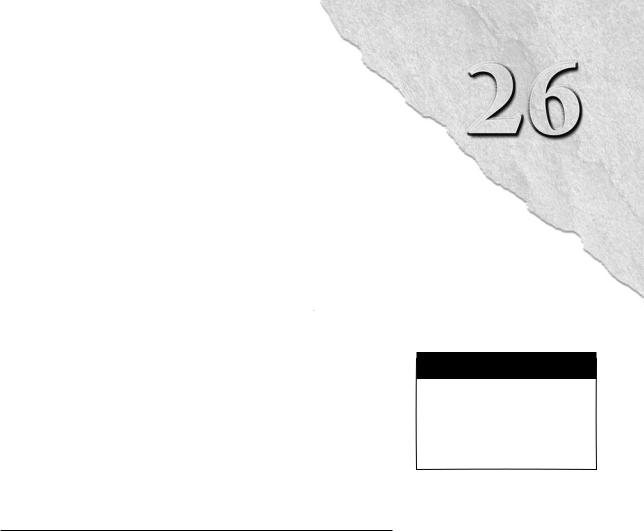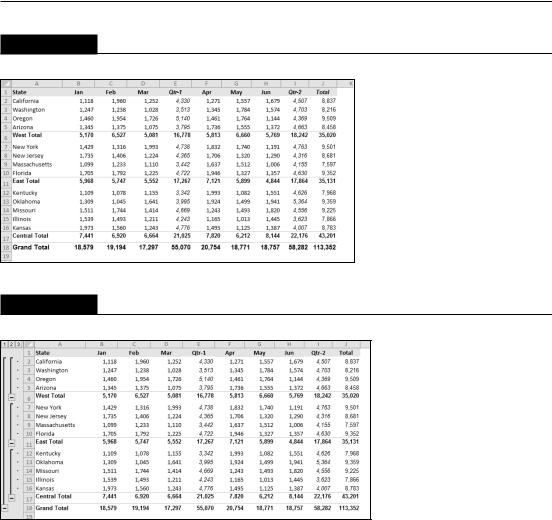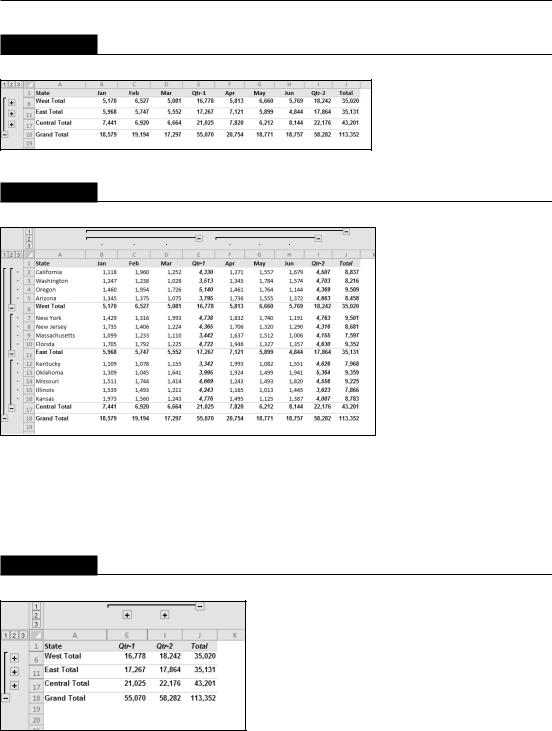
- •About the Author
- •About the Technical Editor
- •Credits
- •Is This Book for You?
- •Software Versions
- •Conventions This Book Uses
- •What the Icons Mean
- •How This Book Is Organized
- •How to Use This Book
- •What’s on the Companion CD
- •What Is Excel Good For?
- •What’s New in Excel 2010?
- •Moving around a Worksheet
- •Introducing the Ribbon
- •Using Shortcut Menus
- •Customizing Your Quick Access Toolbar
- •Working with Dialog Boxes
- •Using the Task Pane
- •Creating Your First Excel Worksheet
- •Entering Text and Values into Your Worksheets
- •Entering Dates and Times into Your Worksheets
- •Modifying Cell Contents
- •Applying Number Formatting
- •Controlling the Worksheet View
- •Working with Rows and Columns
- •Understanding Cells and Ranges
- •Copying or Moving Ranges
- •Using Names to Work with Ranges
- •Adding Comments to Cells
- •What Is a Table?
- •Creating a Table
- •Changing the Look of a Table
- •Working with Tables
- •Getting to Know the Formatting Tools
- •Changing Text Alignment
- •Using Colors and Shading
- •Adding Borders and Lines
- •Adding a Background Image to a Worksheet
- •Using Named Styles for Easier Formatting
- •Understanding Document Themes
- •Creating a New Workbook
- •Opening an Existing Workbook
- •Saving a Workbook
- •Using AutoRecover
- •Specifying a Password
- •Organizing Your Files
- •Other Workbook Info Options
- •Closing Workbooks
- •Safeguarding Your Work
- •Excel File Compatibility
- •Exploring Excel Templates
- •Understanding Custom Excel Templates
- •Printing with One Click
- •Changing Your Page View
- •Adjusting Common Page Setup Settings
- •Adding a Header or Footer to Your Reports
- •Copying Page Setup Settings across Sheets
- •Preventing Certain Cells from Being Printed
- •Preventing Objects from Being Printed
- •Creating Custom Views of Your Worksheet
- •Understanding Formula Basics
- •Entering Formulas into Your Worksheets
- •Editing Formulas
- •Using Cell References in Formulas
- •Using Formulas in Tables
- •Correcting Common Formula Errors
- •Using Advanced Naming Techniques
- •Tips for Working with Formulas
- •A Few Words about Text
- •Text Functions
- •Advanced Text Formulas
- •Date-Related Worksheet Functions
- •Time-Related Functions
- •Basic Counting Formulas
- •Advanced Counting Formulas
- •Summing Formulas
- •Conditional Sums Using a Single Criterion
- •Conditional Sums Using Multiple Criteria
- •Introducing Lookup Formulas
- •Functions Relevant to Lookups
- •Basic Lookup Formulas
- •Specialized Lookup Formulas
- •The Time Value of Money
- •Loan Calculations
- •Investment Calculations
- •Depreciation Calculations
- •Understanding Array Formulas
- •Understanding the Dimensions of an Array
- •Naming Array Constants
- •Working with Array Formulas
- •Using Multicell Array Formulas
- •Using Single-Cell Array Formulas
- •Working with Multicell Array Formulas
- •What Is a Chart?
- •Understanding How Excel Handles Charts
- •Creating a Chart
- •Working with Charts
- •Understanding Chart Types
- •Learning More
- •Selecting Chart Elements
- •User Interface Choices for Modifying Chart Elements
- •Modifying the Chart Area
- •Modifying the Plot Area
- •Working with Chart Titles
- •Working with a Legend
- •Working with Gridlines
- •Modifying the Axes
- •Working with Data Series
- •Creating Chart Templates
- •Learning Some Chart-Making Tricks
- •About Conditional Formatting
- •Specifying Conditional Formatting
- •Conditional Formats That Use Graphics
- •Creating Formula-Based Rules
- •Working with Conditional Formats
- •Sparkline Types
- •Creating Sparklines
- •Customizing Sparklines
- •Specifying a Date Axis
- •Auto-Updating Sparklines
- •Displaying a Sparkline for a Dynamic Range
- •Using Shapes
- •Using SmartArt
- •Using WordArt
- •Working with Other Graphic Types
- •Using the Equation Editor
- •Customizing the Ribbon
- •About Number Formatting
- •Creating a Custom Number Format
- •Custom Number Format Examples
- •About Data Validation
- •Specifying Validation Criteria
- •Types of Validation Criteria You Can Apply
- •Creating a Drop-Down List
- •Using Formulas for Data Validation Rules
- •Understanding Cell References
- •Data Validation Formula Examples
- •Introducing Worksheet Outlines
- •Creating an Outline
- •Working with Outlines
- •Linking Workbooks
- •Creating External Reference Formulas
- •Working with External Reference Formulas
- •Consolidating Worksheets
- •Understanding the Different Web Formats
- •Opening an HTML File
- •Working with Hyperlinks
- •Using Web Queries
- •Other Internet-Related Features
- •Copying and Pasting
- •Copying from Excel to Word
- •Embedding Objects in a Worksheet
- •Using Excel on a Network
- •Understanding File Reservations
- •Sharing Workbooks
- •Tracking Workbook Changes
- •Types of Protection
- •Protecting a Worksheet
- •Protecting a Workbook
- •VB Project Protection
- •Related Topics
- •Using Excel Auditing Tools
- •Searching and Replacing
- •Spell Checking Your Worksheets
- •Using AutoCorrect
- •Understanding External Database Files
- •Importing Access Tables
- •Retrieving Data with Query: An Example
- •Working with Data Returned by Query
- •Using Query without the Wizard
- •Learning More about Query
- •About Pivot Tables
- •Creating a Pivot Table
- •More Pivot Table Examples
- •Learning More
- •Working with Non-Numeric Data
- •Grouping Pivot Table Items
- •Creating a Frequency Distribution
- •Filtering Pivot Tables with Slicers
- •Referencing Cells within a Pivot Table
- •Creating Pivot Charts
- •Another Pivot Table Example
- •Producing a Report with a Pivot Table
- •A What-If Example
- •Types of What-If Analyses
- •Manual What-If Analysis
- •Creating Data Tables
- •Using Scenario Manager
- •What-If Analysis, in Reverse
- •Single-Cell Goal Seeking
- •Introducing Solver
- •Solver Examples
- •Installing the Analysis ToolPak Add-in
- •Using the Analysis Tools
- •Introducing the Analysis ToolPak Tools
- •Introducing VBA Macros
- •Displaying the Developer Tab
- •About Macro Security
- •Saving Workbooks That Contain Macros
- •Two Types of VBA Macros
- •Creating VBA Macros
- •Learning More
- •Overview of VBA Functions
- •An Introductory Example
- •About Function Procedures
- •Executing Function Procedures
- •Function Procedure Arguments
- •Debugging Custom Functions
- •Inserting Custom Functions
- •Learning More
- •Why Create UserForms?
- •UserForm Alternatives
- •Creating UserForms: An Overview
- •A UserForm Example
- •Another UserForm Example
- •More on Creating UserForms
- •Learning More
- •Why Use Controls on a Worksheet?
- •Using Controls
- •Reviewing the Available ActiveX Controls
- •Understanding Events
- •Entering Event-Handler VBA Code
- •Using Workbook-Level Events
- •Working with Worksheet Events
- •Using Non-Object Events
- •Working with Ranges
- •Working with Workbooks
- •Working with Charts
- •VBA Speed Tips
- •What Is an Add-In?
- •Working with Add-Ins
- •Why Create Add-Ins?
- •Creating Add-Ins
- •An Add-In Example
- •System Requirements
- •Using the CD
- •What’s on the CD
- •Troubleshooting
- •The Excel Help System
- •Microsoft Technical Support
- •Internet Newsgroups
- •Internet Web sites
- •End-User License Agreement

CHAPTER
Creating and Using
Worksheet Outlines
If you use a word processor, you may be familiar with the concept of an outline. Most word processors (including Microsoft Word) have an outline mode that lets you view only the headings and subheadings in your document. You can easily expand a heading to show the text below it. Using
an outline makes visualizing the structure of your document easy.
Excel also is capable of using outlines, and understanding this feature can make working with certain types of worksheets much easier for you.
Introducing Worksheet Outlines
You’ll find that some worksheets are more suitable for outlines than others. You can use outlines to create summary reports in which you don’t want to show all the details. If your worksheet uses hierarchical data with subtotals, it’s probably a good candidate for an outline.
The best way to understand how worksheet outlining works is to look at an example. Figure 26.1 shows a simple sales summary sheet without an outline. Formulas are used to calculate subtotals by region and by quarter.
Figure 26.2 shows the same worksheet after I created the outline. Notice that Excel adds a new section to the left of the screen. This section contains outline controls that enable you to determine which level to view. This particular outline has three levels: States, Regions (each region consists of states grouped into categories such as West, East, and Central), and Grand Total (the sum of each region’s subtotal).
IN THIS CHAPTER
Introducing worksheet outlines
Creating an outline
Using outlines
581

Part IV: Using Advanced Excel Features
FIGURE 26.1
A simple sales summary with subtotals.
FIGURE 26.2
The worksheet after creating an outline.
Figure 26.3 depicts the outline after clicking the 2 button, which displays the second level of details. Now, the outline shows only the totals for the regions (the detail rows are hidden). You can partially expand the outline to show the detail for a particular region by clicking one of the + buttons. Collapsing the outline to level 1 shows only the headers and the Grand Total row.
Excel can create outlines in both directions. In the preceding examples, the outline is a row (vertical) outline. Figure 26.4 shows the same model after a column (horizontal) outline was added. Now, Excel also displays outline controls at the top.
582

Chapter 26: Creating and Using Worksheet Outlines
FIGURE 26.3
The worksheet after collapsing the outline to the second level.
FIGURE 26.4
The worksheet after adding a column outline.
If you create both a row and a column outline in a worksheet, you can work with each outline independent of the other. For example, you can show the row outline at the second level and the column outline at the first level. Figure 26.5 shows the model with both outlines collapsed at the second level. The result is a nice high-level summary table that gives regional totals by quarter.
FIGURE 26.5
The worksheet with both outlines collapsed at the second level.
583

Part IV: Using Advanced Excel Features
On the CD
You can find the workbook used in the preceding examples on this book’s CD-ROM. The file is named outline example.xlsx.
Keep in mind the following points about worksheet outlines:
•A worksheet can have only one outline. If you need to create more than one outline, move the data to a new worksheet.
•You can either create an outline manually or have Excel do it for you automatically. If you choose the latter option, you may need to do some preparation to get the worksheet in the proper format. You can read later in this chapter how to use both methods.
•You can create an outline for either all data on a worksheet or just a selected data range.
•You can remove an outline with a single command. (Read how in the upcoming section, “Removing an outline.”) However, the data remains.
•You can hide the outline symbols (to free screen space) but retain the outline. I show you how in this chapter.
•An outline can have up to eight nested levels.
Worksheet outlines can be quite useful. If your main objective is to summarize a large amount of data, though, you may be better off using a pivot table. A pivot table is much more flexible and doesn’t require that you create the subtotal formulas; it does the summarizing for you automatically. The ultimate solution depends upon your data source. If you’re entering data from scratch, the most flexible approach is to enter it in a normalized table format, and create a pivot table.
Cross-Reference
I discuss pivot tables (and normalized data) in Chapters 34 and 35. n
Creating an Outline
This section describes the two ways to create an outline: automatically and manually. Before you create an outline, you need to ensure that data is appropriate for an outline and that the formulas are set up properly.
Preparing the data
What type of data is appropriate for an outline? Generally, the data should be arranged in a hierarchy, such as a budget that consists of an arrangement similar to the following:
Company
Division
Department
Budget Category
Budget Item
584

Chapter 26: Creating and Using Worksheet Outlines
In this case, each budget item (for example, airfare and hotel expenses) is part of a budget category (for example, travel expenses). Each department has its own budget, and the departments are rolled up into divisions. The divisions make up the company. This type of arrangement is well suited for a row outline.
Cross-Reference
The data arrangement suitable for an outline is essentially a summary table of your data. In some situations, your data will be “normalized” data — one data point per row. You can easily create a pivot table to summarize such data, and a pivot table is much more flexible than dealing with an outline. See Chapters 34 and 35 for more information on pivot tables. n
After you create such an outline, you can view the information at any level of detail that you want by clicking the outline controls. When you need to create reports for different levels of management, consider using an outline. For example, upper management may want to see only the division totals. Division managers may want to see totals by department, and each department manager needs to see the full details for his or her department.
Keep in mind that using an outline isn’t a security feature. The data that’s hidden when an outline is collapsed can easily be revealed when the outline is expanded.
You can include time-based information that is rolled up into larger units (such as months and quarters) in a column outline. Column outlines work just like row outlines, however, and the levels need not be time based.
Before you create an outline, you need to make sure that all the summary formulas are entered correctly and consistently. In this context, consistently means that the formulas are in the same relative location. Generally, formulas that compute summary formulas (such as subtotals) are entered below the data to which they refer. In some cases, however, the summary formulas are entered above the referenced cells. Excel can handle either method, but you must be consistent throughout the range that you outline. If the summary formulas aren’t consistent, automatic outlining won’t produce the results that you want.
Note
If your summary formulas aren’t consistent (that is, some are above and some are below the data), you still can create an outline, but you must do it manually. n
Creating an outline automatically
Excel can create an outline for you automatically in a few seconds, whereas it may take you 10 minutes or more to do the same thing manually.
Note
If you have created a table for your data (Insert Tables Table), Excel can’t create an outline automatically. You can create an outline from a table, but you must do so manually. n
585

Part IV: Using Advanced Excel Features
To have Excel create an outline, move the cell pointer anywhere within the range of data that you’re outlining. Then, choose Data Outline Group Auto Outline. Excel analyzes the formulas in the range and creates the outline. Depending on the formulas that you have, Excel creates a row outline, a column outline, or both.
If the worksheet already has an outline, Excel asks whether you want to modify the existing outline. Click Yes to force Excel to remove the old outline and create a new one.
Note
Excel automatically creates an outline when you choose Data Outline Subtotal, which inserts subtotal formulas automatically. n
Creating an outline manually
Usually, letting Excel create the outline is the best approach. It’s much faster and less error prone. If the outline that Excel creates isn’t what you have in mind, however, you can create an outline manually.
When Excel creates a row outline, the summary rows must all be below the data or all above the data: They can’t be mixed. Similarly, for a column outline, the summary columns must all be to the right of the data or to the left of the data. If your worksheet doesn’t meet these requirements, you have two choices:
•Rearrange the worksheet so that it does meet the requirements.
•Create the outline manually.
You also need to create an outline manually if the range doesn’t contain any formulas. You may have imported a file and want to use an outline to display it better. Because Excel uses the positioning of the formulas to determine how to create the outline, it cannot make an outline without formulas.
Creating an outline manually consists of creating groups of rows (for row outlines) or groups of columns (for column outlines). To create a group of rows
1. Click the row numbers for all the rows that you want to include in the group.
Caution
Do not select the row that has the summary formulas. You don’t want these rows to be included in the group. n
2.Choose Data Outline Group Group. Excel displays outline symbols for the group.
3.Repeat this process for each group that you want to create. When you collapse the outline, Excel hides rows in the group, but the summary row, which isn’t in the group, remains in view.
586
